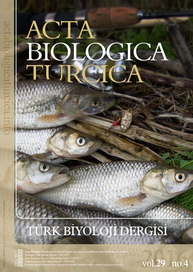Otolith morphometry and scanning electron microscopy analysis of three fish species from the Black Sea
Abstract
Keywords
Full Text:
PDFReferences
Aguirre, H., & Lombarte, A. (1999). Ecomorphological comparisons of sagittae in Mullus barbatus and M. surmuletus. Journal of Fish Biology, 55, 105–114. https://doi.org/10.1111/j.1095-8649.1999.tb00660.x
Başçınar, N. S., & Atılgan, E. (2016). Otolith morphometry and shape analysis of Anchovy (Engraulis encrasicolus, L. 1758) living in different regions Black Sea: Ukraine and Türkiye (Rize, Samsun). Aquaculture Studies, 16(4), 311-320. https://doi.org/10.17693/yunusae.v16i26717.281030
Bostancı, D. (2009). Sarıkuyruk İstavrit, Trachurus mediterraneus (Steindachner, 1868)’un otolit özellikleri ve bazı populasyon parametreleri, Fırat Üniversitesi Fen Mühendislik Bilimleri Dergisi, 21(1), 53-60.
Campana S. E., & Casselmen J. M. (1993). Stock discrimination using otolith shape analysis, Canadian Journal of Fisheries and Aquatic Sciences, 50, 162-1083. https://doi.org/10.1139/f93-123
Çiçek, E., Avşar, D., Yeldan, H., & Manaşırlı, M. (2020). Comparative morphology of the sagittal otolith of mullet species (Mugilidae) from the Iskenderun Bay, north-eastern Mediterranean. Acta Biologica Turcica, 33(4), 219-226.
Karlou-Riga, C. (2000). Otolith morphology and age and growth of Trachurus mediterraneus (Steindahner) in the Eastern Mediterranean. Fisheries Research, 46, 69-82. https://doi.org/10.1016/S0165-7836(00)00134-X
Milošević, D., Pešić, A., Ikica, Z., Mitrović, T., & Paskaš, N. (2021). Biometry of the sagittal otoliths for three demersal fish species from the Eastern Adriatic Sea (Montenegro). Acta Adriatica, 62(2), 171-182. https://doi.org/10.32582/aa.62.2.5
Mohamed, S. B., Mejri, M., Ben Faleh, A., Allaya, H., Jmil, I., Rebaya, M., Chalh, A., Quignard, J.-P., & Trabelsi, M. (2019). Otolith shape as a valuable tool to evaluate the stock structure of Mullus barbatus from two Tunisian lagoons (Boughrara and El Biban). Cahiers de Biologie Marine, 60, 507-516. https://doi.org/10.21411/CBM.A.873DBD51
Mohamed, S. B., Mejri, M., Chalh, A., Shahin, A. A. B., Quignard, J.-P., Trabelsi, M., & Faleh, A. B. (2023). Distinct inter and intrapopulation variation in the otolith shape and size of Mullus barbatus (Actinopterygii: Mullidae) from the Bizerte and Ghar El Melh lagoons in Tunisian waters. Marine Biology Research, 19(4-5) 234-248. https://doi.org/10.1080/17451000.2023.2203503
Morat, F., Letourneur, Y., Nérini, D., Banaru, D., & Batjakas, I. E. (2012). Discrimination of red mullet populations (Teleostean, Mullidae) along multi-spatial and ontogenetic scales within the Mediterranean basin on the basis of otolith shape analysis. Aquatic Living Resources, 25, 27–39. https://doi.org/10.1051/alr/2011151
Özpiçak, M., Saygın, S., & Polat, N. (2019). Otolith shape analysis of Bluefish, Pomatomus saltatrix (Linnaeus, 1766) in the Black Sea Region (Samsun, Turkey). Acta Aquatica Turcica, 15(4), 507-516. https://doi.org/10.22392/actaquatr.559899
Ponton D. (2006). Is geometric morphometrics efficient for comparing otolith shape of different fish species?, Journal of Morphology, 267, 750-757. https://doi.org/10.1002/jmor.10439
Skeljo, F., & Ferri, J. (2012). The use of otolith shape and morphometry for identification and size-estimation of five wrasse species in predator-prey studies. Journal of Applied Ichthyology, 28, 524–530. https://doi.org/10.1111/j.1439-0426.2011.01925.x
Süer, S. (2008). Determination of age and growth model of Red mullet Mullus barbatus ponticus (Essipov 1927) (Mullidae) by means of otolith reading and length-frequency analysis. MSc Thesis, Ondokuz Mayıs University, 99p.
Süer, S. (2016). Comparative analysis of population parameters by age-based methods, in Whiting (Merlangius merlangus L., 1758) and Red mullet (Mullus barbatus L., 1758) stocks under different fishing pressures in Black Sea. PhD Thesis, Ondokuz Mayıs University, 243p.
Tayhan, Y. (2014). The investigation of the possible spatial variations in otolith morphology and genetic traits from the Whiting (Merlangius merlangus euxinus (Nordmann, 1840)) ınhabiting benthopelagic waters in central and southeastern Black Sea. PhD Thesis, Ondokuz Mayıs University, 121p.
Tuset V. M., Lombarte, A., Gonzales, J. A., Pertusa, J. F., & Lorente, M. J. (2003). Comparative morphology of the sagittal otolith in Serranus spp.. Journal of Fish Biology, 63, 1491-1504. https://doi.org/10.1111/j.1095-8649.2003.00262.x
Tuset V. M., Lombarte A., & Assis C. A. (2008). Otolith atlas for the western Mediterranean, north and central eastern Atlantic. Scientia Marina, 72,S1, 7-198. https://doi.org/10.3989/scimar.2008.72s17
Viva, C., Sartor, P., Bertolini, D., De Ranieri, S., & Ligas, A. (2015). Relationship of otolith length to fish total length in six demersal species from the NW Mediterranean Sea. Journal of Applied Ichthyology, 31, 973-974. https://doi.org/10.1111/jai.12838
Yedier, S., Bostancı, D., Kontaş, S., Kurucu, G., & Polat, N. (2018). Fluctuating asymmetry in otolith dimensions of Trachurus mediterraneus collected from the Middle Black Sea. Acta Biologica Turcica, 31(4), 152-159.
Yedier, S., & Bostanci, D. (2020). Aberrant otoliths in four marine fishes from the Aegean Sea, Black Sea, and Sea of Marmara (Turkey). Regional Studies in Marine Science, 34, 101011. https://doi.org/10.1016/j.rsma.2019.101011
Yoraz, A. (2015). Morphometric description and visual analysis of the annulus formation in sagittal otoliths of some pelagic and demersal fish species in the middle Black Sea region fishery. PhD Thesis, Ondokuz Mayıs University, 407p.
Zengin, M., Saygın, S., & Polat, N. (2015). Otolith shape analyses and dimensions of the Anchovy Engraulis encrasicolus L. in the Black and Marmara Seas. Sains Malaysiana, 44(5), 657–662. https://doi.org/10.17576/jsm-2015-4405-03
Zorica B., Sinovcic G., & Cikes Kec V. (2010). Preliminary data on the study of otolith morphology of five pelagic fish species from the Adriatic Sea (Croatia). Acta Adriatica, 51 (1), 89-96.
Refbacks
- There are currently no refbacks.

